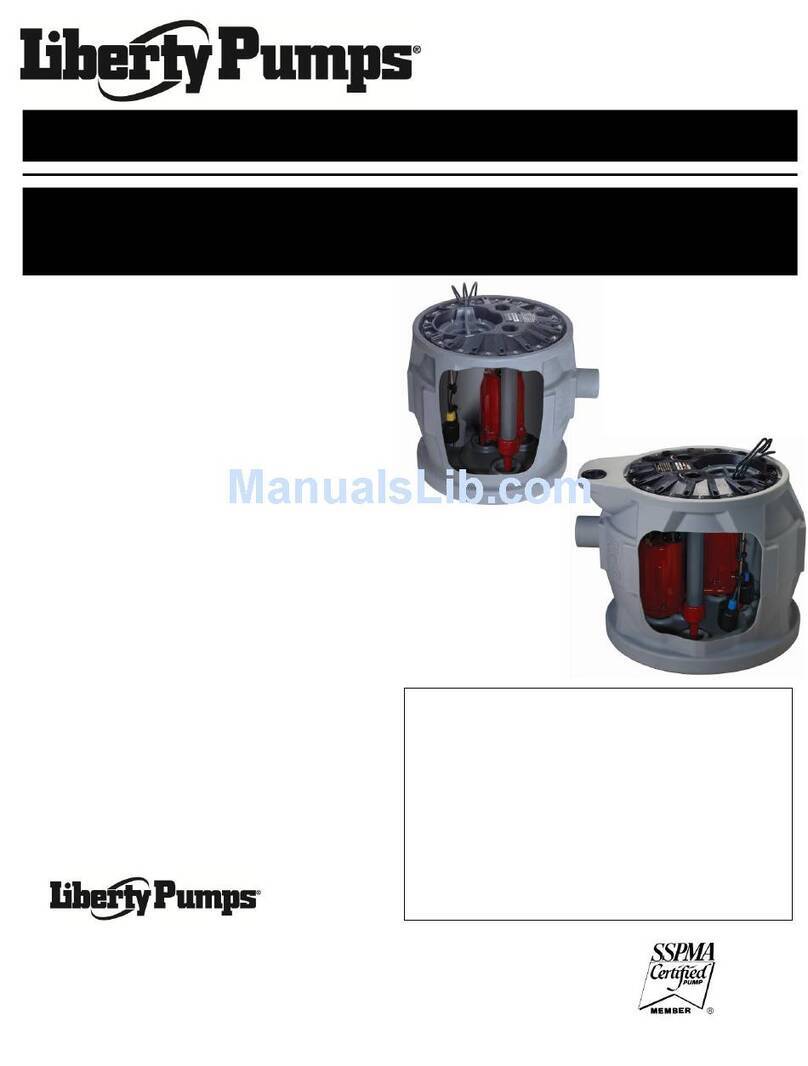
©Copyright 2012 Liberty Pumps Inc. All rights reserved - 5 -
3-2 STORAGE BEFORE USE
Liberty pumps are shipped from the factory ready for installation and use. They should be held in storage if the
pump station is not complete. If storage is necessary, the pump should remain in its shipping container. It should
be stored in a warehouse or storage shed that has a clean, dry temperature-stable area where the pump and its
container should be covered to protect it from water, dirt, dust, etc. The ends of the cables - (plugs) must be
protected against moisture.
AT NO TIME SHOULD THE PUMP BE STORED WITHIN AN INCOMPLETE WET PIT. THE PUMP
SHOULD NOT BE PLACED INTO THE PIT UNTIL IT CAN BE FULLY OPERATED.
LONG TERM STORAGE
1. If it is necessary to store a pump for a long period of time, it should be stored indoors in a clean, dry temperature-
stable environment. The pump should be covered to protect it from dust, dirt and water. The plug end of the
cable must be protected against moisture.
2. Do not allow the pump to freeze.
3. Prior to installation, the pump motor should be rotated to ensure the seals and cutters are free spinning.
4. Installed pumps which are idle for long periods of time should be manually operated through the breaker panel
once a month to lubricate the seals. Turn off the breaker, unplug the piggyback switch, and plug the pump
directly into the wall socket. Turn the breaker on for 30 seconds. Turn the breaker off, and then plug the
piggyback switch back in. (refer to Section 4-1)
3-3 PUMP INSTALLATION
THIS PUMP IS NOT TO BE INSTALLED IN LOCATIONS CLASSIFIED AS HAZARDOUS IN
ACCORDANCE WITH THE NATIONAL ELECTRICAL CODE,ANSI/NFPA 70.
Grinder pumps must be installed in a tank that is vented in accordance with local plumbing codes.
Installation should be at a sufficient depth to ensure that all plumbing is below the frost line. If this is not feasible,
remove the check valve and size the basin and/or adjust pump differential to accommodate the additional
backflow volume. Consult the factory for details on how this should be done.
The Omnivore Grinders may be guide rail mounted using Liberty's GR20 guide rail base, or stand-alone. (See
Figure 3, page 11) They may be installed as a completely packaged simplex (single pump) or duplex (two-pump)
system. Installation of the pump shall be in accordance with state and local codes and performed only by
qualified personnel. Typical installations consist of a guide rail mount in a fiberglass, concrete or polyethylene
tank. This section assumes guide rail installation.
NEVER LIFT THE PUMP BY PULLING ON THE POWER CORD.
USE THE LIFTING CHAIN OR CABLE ONLY
1. Liberty GR20 Guide Rail systems feature a self-aligning mounting bracket. Using the lifting chain, slip the pump
bracket over the upper guide rail bracket. Lower the pump at an angle down the guide rail into the tank. (See
Figure 3, page 11)
2. As the pump nears its final position, the straightening rib squares the pump bracket with the guide bracket ears.
When the pump bracket ears hook the guide bracket ears, the chain will slacken.
3. Grasp the lifting chain and shake the pump to ensure a good seat with the gasket. The pump is suspended by
the bracket ears. The weight of the pump compresses the gasket against the mating flange of the guide bracket
base.
4. The lifting chain may be removed from the hoist and hooked near the upper guide rail bracket.




























